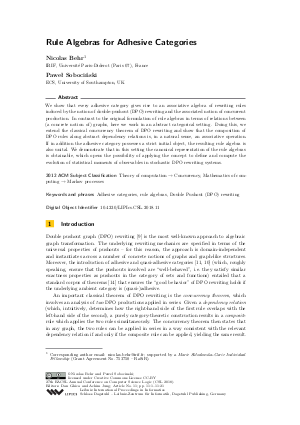Rule Algebras for Adhesive Categories
Authors Nicolas Behr, Pawel Sobocinski
-
Part of:
Volume:
27th EACSL Annual Conference on Computer Science Logic (CSL 2018)
Part of: Series: Leibniz International Proceedings in Informatics (LIPIcs)
Part of: Conference: Computer Science Logic (CSL) - License:
 Creative Commons Attribution 3.0 Unported license
Creative Commons Attribution 3.0 Unported license
- Publication Date: 2018-08-29
File

PDF
LIPIcs.CSL.2018.11.pdf
- Filesize: 0.77 MB
- 21 pages
Document Identifiers
Subject Classification
ACM Subject Classification
- Theory of computation → Concurrency
- Mathematics of computing → Markov processes
Keywords
- Adhesive categories
- rule algebras
- Double Pushout (DPO) rewriting
Metrics
- Access Statistics
-
Total Accesses (updated on a weekly basis)
0Document
0Metadata
Abstract
We show that every adhesive category gives rise to an associative algebra of rewriting rules induced by the notion of double-pushout (DPO) rewriting and the associated notion of concurrent production. In contrast to the original formulation of rule algebras in terms of relations between (a concrete notion of) graphs, here we work in an abstract categorical setting. Doing this, we extend the classical concurrency theorem of DPO rewriting and show that the composition of DPO rules along abstract dependency relations is, in a natural sense, an associative operation. If in addition the adhesive category possesses a strict initial object, the resulting rule algebra is also unital. We demonstrate that in this setting the canonical representation of the rule algebras is obtainable, which opens the possibility of applying the concept to define and compute the evolution of statistical moments of observables in stochastic DPO rewriting systems.
Cite As Get BibTex
Nicolas Behr and Pawel Sobocinski. Rule Algebras for Adhesive Categories. In 27th EACSL Annual Conference on Computer Science Logic (CSL 2018). Leibniz International Proceedings in Informatics (LIPIcs), Volume 119, pp. 11:1-11:21, Schloss Dagstuhl – Leibniz-Zentrum für Informatik (2018)
https://doi.org/10.4230/LIPIcs.CSL.2018.11
BibTex
@InProceedings{behr_et_al:LIPIcs.CSL.2018.11,
author = {Behr, Nicolas and Sobocinski, Pawel},
title = {{Rule Algebras for Adhesive Categories}},
booktitle = {27th EACSL Annual Conference on Computer Science Logic (CSL 2018)},
pages = {11:1--11:21},
series = {Leibniz International Proceedings in Informatics (LIPIcs)},
ISBN = {978-3-95977-088-0},
ISSN = {1868-8969},
year = {2018},
volume = {119},
editor = {Ghica, Dan R. and Jung, Achim},
publisher = {Schloss Dagstuhl -- Leibniz-Zentrum f{\"u}r Informatik},
address = {Dagstuhl, Germany},
URL = {https://drops.dagstuhl.de/entities/document/10.4230/LIPIcs.CSL.2018.11},
URN = {urn:nbn:de:0030-drops-96781},
doi = {10.4230/LIPIcs.CSL.2018.11},
annote = {Keywords: Adhesive categories, rule algebras, Double Pushout (DPO) rewriting}
}
Author Details
Funding
- Behr, Nicolas: Corresponding author email: nicolas.behr@irif.fr; supported by a Marie Skłodowska-Curie Individual Fellowship (Grant Agreement No. 753750 - RaSiR).
References
- OEIS Foundation Inc. (2018), The On-Line Encyclopedia of Integer Sequences, https://oeis.org/A286030.
-
Nicolas Behr, Vincent Danos, and Ilias Garnier. Stochastic mechanics of graph rewriting. Proceedings of the 31st Annual ACM-IEEE Symposium on Logic in Computer Science (LICS 2016), pages 46-55, 2016.

-
Nicolas Behr, Vincent Danos, and Ilias Garnier. Combinatorial Conversion and Moment Bisimulation for Stochastic Rewriting Systems (in preparation), 2018.

- Nicolas Behr, Vincent Danos, Ilias Garnier, and Tobias Heindel. The algebras of graph rewriting. https://arxiv.org/abs/1612.06240, 2016.
- Nicolas Behr, Gerard HE Duchamp, and Karol A Penson. Combinatorics of Chemical Reaction Systems. https://arxiv.org/abs/1712.06575, 2017.
-
Pawel Blasiak, Gerard HE Duchamp, Allan I Solomon, Andrzej Horzela, Karol A Penson, et al. Combinatorial Algebra for second-quantized Quantum Theory. Advances in Theoretical and Mathematical Physics, 14(4):1209-1243, 2010.

-
Pawel Blasiak and Philippe Flajolet. Combinatorial Models of Creation-Annihilation. Séminaire Lotharingien de Combinatoire, 65(B65c):1-78, 2011.

-
Andrea Corradini, Ugo Montanari, Francesca Rossi, Hartmut Ehrig, Reiko Heckel, and Michael Löwe. Algebraic Approaches to Graph Transformation - Part I: Basic Concepts and Double Pushout Approach. In Handbook of Graph Grammars and Computing by Graph Transformations, Volume 1: Foundations, pages 163-246, 1997.

-
Hartmut Ehrig and Hans-Jörg Kreowski. Parallelism of manipulations in multidimensional information structures. In Mathematical Foundations of Computer Science, number 45 in LNCS, pages 284-293. Springer, 1976.

-
Richard Garner and Stephen Lack. On the axioms for adhesive and quasiadhesive categories. Theor. App. Categories, 27(3):27-46, 2012.

-
Stephen Lack and Paweł Sobociński. Adhesive and quasiadhesive categories. RAIRO-Theoretical Informatics and Applications, 39(3):511-545, 2005.

-
Stephen Lack and Paweł Sobociński. Toposes are adhesive. In Graph Transformations, Third International Conference, (ICGT 2006), volume 4178 of LNCS, pages 184-198. Springer, 2006.

-
James R. Norris. Markov Chains. Cambridge Series in Statistical and Probabilistic Mathematics. Cambridge University Press, 1998.

-
Grzegorz Rozenberg, editor. Handbook of Graph Grammars and Computing by Graph Transformations, Volume 1: Foundations. World Scientific, 1997.

